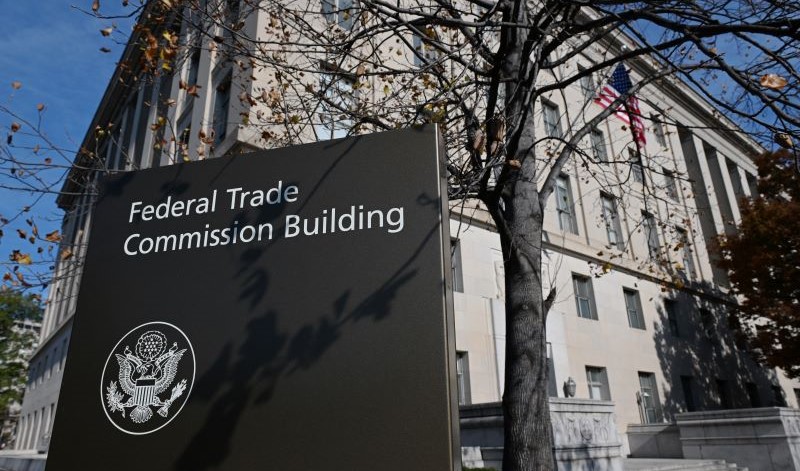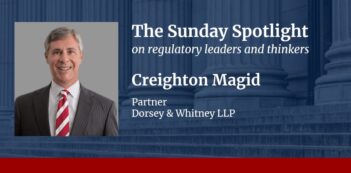
Removal of commissioners runs counter to a 90-year-old precedent, teeing up a potential Supreme Court case.
President Donald J. Trump, just two months after retaking office, fired two Democratic commissioners of the U.S. Federal Trade Commission (FTC) without cause. The question, potentially bound for the U.S. Supreme Court, is whether President Trump had the power to do so.
Alvaro Bedoya and Rebecca Kelly Slaughter, the two fired commissioners, claim that the President did not have that power. The commissioners sued, seeking to “vindicate their right to serve the remainder of their respective terms.”
The Trump Administration, however, through a letter from Acting Solicitor General Sarah Harris to a congressional committee, stated that the statutory protection in the Federal Trade Commission Act is unconstitutional and that the U.S. Department of Justice will “no longer defend” it—or similar protections for other independent agency heads—in court. The Act prevents removal of commissioners appointed to seven-year terms except for cause—defined in the FTC Act as “inefficiency, neglect of duty, or malfeasance in office.”
The FTC is an independent agency that was established in 1914 by the FTC Act to protect consumers from “deceptive or unfair business practices” and promote competition. Among the FTC’s delegated powers is the ability to sue businesses and individuals for violating the antitrust laws and engaging in unfair competition, fraud, and deception.
The FTC has also asserted the power to issue rules, both on unfair or deceptive acts and practices as well as on unfair methods of competition. A judge in August 2024, however, ruled that “the FTC lacks substantive rulemaking authority with respect to unfair methods of competition.” The FTC has appealed the decision.
According to the FTC Act, the FTC is headed by five commissioners confirmed by the U.S. Senate, no more than three of whom may be members of the same political party. The agency is led by a chair chosen by the President from among the sitting commissioners. The chair is normally affiliated with the President’s political party.
Shortly after the second Trump Administration began, Lina Khan—then the FTC chair who served as a Democrat on the commission during the Biden Administration—resigned from the FTC, allowing President Trump to nominate another commissioner and designate a new chair.
As is common, the two remaining Democratic commissioners stayed on, leaving the FTC with four total commissioners, two of them Republicans appointed by President Joseph R. Biden. President Trump followed Khan’s resignation by nominating a new Republican member and designating Andrew Ferguson, an existing Republican member, to serve as chair.
In an unusual move, however, President Trump also fired the remaining Democrats, opening the seats for him to nominate commissioners of his choosing.
Their removals, if challenged in court, could lay the groundwork for the Supreme Court to revisit its 1935 decision in Humphrey’s Executor v. United States.
In that case, the Court addressed a President’s authority to remove an FTC member without cause after President Franklin D. Roosevelt removed a Republican commissioner for opposing New Deal policies. President Roosevelt sought to replace the commissioner with a person he chose.
The Supreme Court unanimously held that a President could only dismiss an FTC commissioner for cause. The case established the constitutional principle that the U.S. Congress may limit the President’s power to remove the heads of independent agencies that perform what the court called “quasi-legislative” and “quasi-judicial” functions, as opposed to executive functions, which are “vested by the Constitution in the President.”
As the Court noted, the FTC acted legislatively by “making investigations and reports for the information of Congress,” and judicially by acting as “a master in chancery.”
Although the Court in Seila Law v. Consumer Financial Protection Bureau struck down as unconstitutional for-cause removal protections for a single-headed agency, the Court did not overrule Humphrey’s Executor. Instead, the Court emphasized that Humphrey’s Executor established an “exception” to the general rule that the President may freely remove executive agency heads even if a statute limits the President’s authority to remove them for-cause.
Humphrey’s Executor, the Court explained, only “permitted Congress to give for-cause removal protections to a multimember body of experts, balanced along partisan lines, that performed legislative and judicial functions and was said not to exercise any executive power.”
A footnote in Seila Law may have foreshadowed a potential challenge to the precedent. Chief Justice Roberts, writing for the majority, stated that the Court’s conclusion in Humphrey’s Executor “that the FTC did not exercise executive power has not withstood the test of time.”
Acting Solicitor General Harris honed in on Chief Justice Roberts’s characterization of the FTC in her letter to Congress, stating that the FTC—and other agencies, such as the U.S. National Labor Relations Board and the U.S. Consumer Product Safety Commission—“exercise substantial executive power,” including by issuing regulations.
The recently fired commissioner’s threatened lawsuit could provide an opportunity for the Supreme Court to revisit Humphrey’s Executor and determine that the FTC falls outside of the Humphrey’s Executor exception—or overrule the case entirely.
The firings of Bedoya and Slaughter fit into a larger pattern of President Trump’s firings of independent agency heads, indicating a broader effort by the Trump Administration to reshape the legal framework governing them. Shortly after taking office, President Trump fired the chair of the U.S. National Labor Relations Board, Gwynne Wilcox, and two commissioners of the U.S. Equal Employment Opportunity Commission, Jocelyn Samuels and Charlotte Burrows. A few weeks later, he fired Cathy A. Harris, a member of the U.S. Merit Systems Protection Board.
Federal district court judges have ruled recently that Wilcox’s and Harris’s firings violated statutory for-cause removal protections that the courts held are constitutional under Humphrey’s Executor and Seila Law. In the case brought by Wilcox, the judge ruled that Wilcox’s removal was a “blatant violation” of the National Labor Relations Act, which states that the President can only remove a member “upon notice and hearing” for “neglect of duty or malfeasance.” The court explained that President Trump only identified political motivations for the removal. The Justice Department has appealed the decisions in both Wilcox’s and Harris’s cases.
In an executive order issued less than a month after taking office, President Trump laid out his goal to “ensure accountability in government” by implementing presidential oversight over “independent regulatory agencies.” As one scholar expresses, President Trump’s judicial success in asserting control over independent regulatory agencies would result in a “significant shift in power to the White House.”



